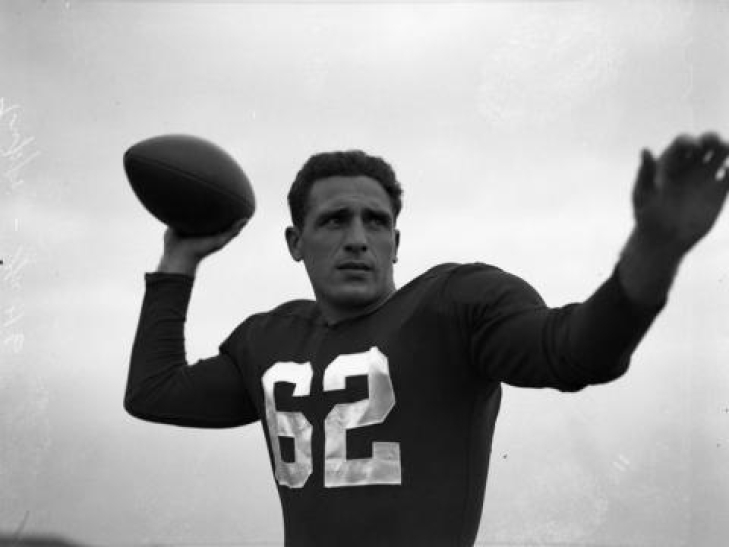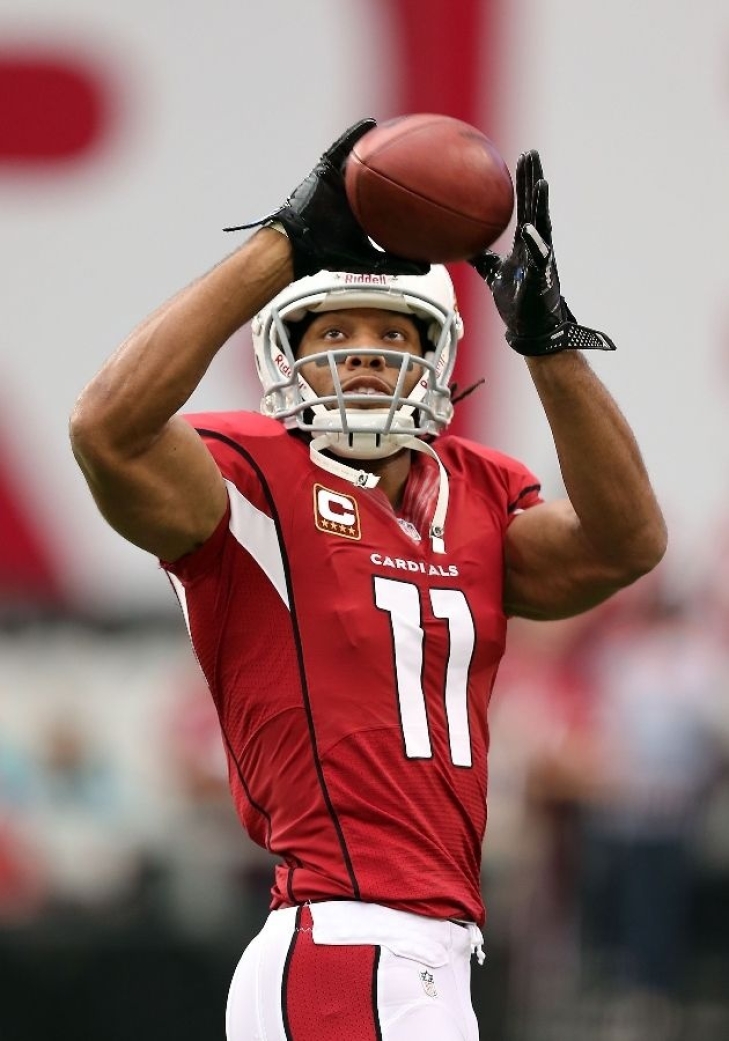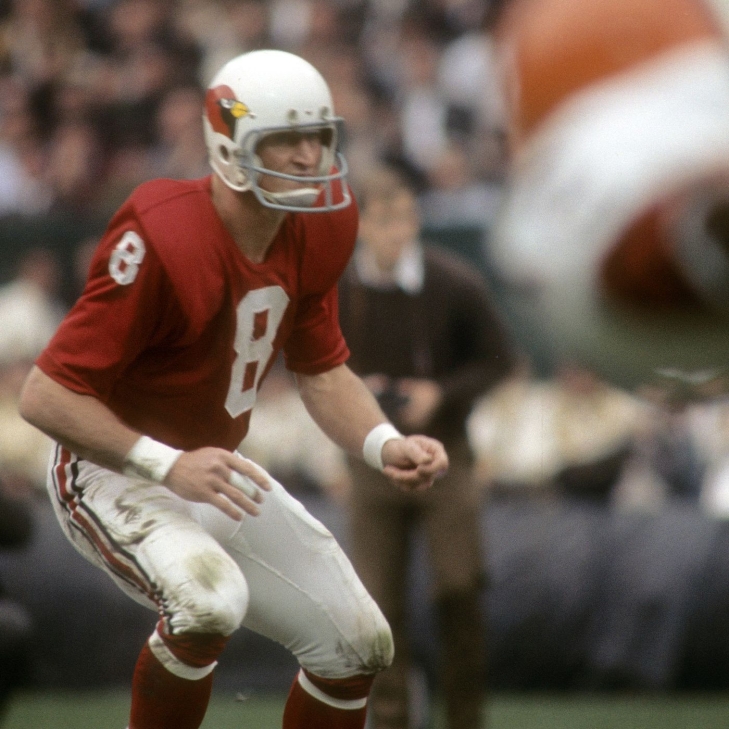
Committee Chairman
3. Charley Trippi
Charley Trippi was a coveted player from the University of Georgia, and the New York Yankees of the upstart All-American Football Conference thought they had him locked up. The Chicago Cardinals, who drafted him first overall, earned his services when Cardinals owner Charles Bidwell signed him to what was a massive contract at the time, $100,000 over four years.
Trippi was the heart of what would become Chicago's "Million Dollar Backfield," as a rookie in 1947, he would lead the Cardinals to an NFL Championship. Incredibly versatile, Trippi could play any offensive skill position and excelled at rushing, passing, and punting. He played until 1955, finishing his career with the Cardinals and amassing 4,827 Yards From Scrimmage.
Trippi was selected for the 1940s All-Decade Team and the Pro Football Hall of Fame in 1968. The Cardinals selected Trippi for their inaugural Ring of Honor class in 2006.
2. Larry Fitzgerald
Named the Big East Offensive Player of the Year in 2003, Larry Fitzgerald shattered his accomplishments at the University of Pittsburgh with a spectacular 17-year career that was spent entirely with Arizona.
After a solid rookie year, Fitzgerald broke out in his sophomore season, accumulating 1,409 Yards and 10 Touchdowns. The 11-time Pro Bowler broke four digits in Yards eight more times and would twice lead the NFL in Touchdown Receptions (2008 & 2009) and Receptions (2005 & 2016). Fitzgerald was the top weapon for Cardinal Quarterbacks for well over a decade, and had it not been for his work, Arizona would not have made their first Super Bowl, where he had 546 Yards and seven Touchdowns in their four Playoff Games.
Fitzgerald was a legend on the field and was equally so off of it, having won the prestigious Walter Payton Man of the Year in 2016.
At the time of his retirement, Fitzgerald ranked second in Receptions and Receiving Yards and was sixth in Receiving Touchdowns. He also holds a myriad of franchise records and receiving records. He was named to the 2010s All-Decade and 100th Anniversary Team and will soon be in the Pro Football Hall of Fame.
1. Larry Wilson
A two-way star at Utah, Larry Wilson barely reached six feet, which was primarily why he dropped to the Seventh Round of the 1960 NFL Draft, and it would not take long to see that he was the steal of the day.
A Cardinal for the entirety of his 12 NFL campaigns, Wilson was one of the most outstanding Safety of the 1960s and helped redefine the position. With his speed and tackling ability, the Cardinals had a player who could execute the Safety Blitz, a novelty at the time. Wilson had 21 (unofficial) Sacks over his career, and in traditional Defensive Back stats, he recorded 52 Interceptions, including a league-leading 10 in 1966, a year where he was second in MVP voting. He was also known for his toughness, having once played with casts on both arms.
From 1962 to 1970, Wilson was named to the Pro Bowl, and he rattled off five consecutive First Team Selections from 1966 to 1970. Not surprisingly, Wilson was chosen for the 50th, 75th, and 100th NFL Anniversary Teams.
Wilson entered the Pro Football of Fame in his first year of eligibility, one of two people (Tom Nix) being the other, to accomplish this astounding feat.
He may never have appeared in a playoff game, but many a game was won for St. Louis because Wilson was on their squad. The Cardinals retired his number 8 in 1970; in 2006, he entered their Ring of Honor.
Metaverse and Sports: A Deep Dive into the Future of Virtual Reality
In the digital age, the metaverse, combined with the allure of virtual reality, is redefining the boundaries of the sports world. Add to this mix the exciting prospects of betting in the metaverse, and you have a transformative cocktail that's shifting how we consume sports content. This article breaks down how the confluence of these elements is elevating the sports experience for fans, athletes, and stakeholders alike.
Virtual Stadiums: A Game-Changer for the Sports Viewing Experience
Gone are the days when watching a game meant being physically present at a stadium or glued to a television set. The advent of virtual stadiums in the metaverse promises fans an immersive experience like never before. Imagine being teleported to a bustling digital coliseum, where you can enjoy a 360-degree panoramic view of a live match. It's not just about watching; it's about feeling the electric atmosphere, virtually rubbing shoulders with fellow fans, and engaging in real-time interactions that blur the lines between the virtual and the real.
Esports and the Metaverse: Where Gaming Meets Reality
Esports, once a niche sector, has burgeoned into a mainstream phenomenon, captivating millions worldwide. However, when you integrate it with the metaverse, you witness a transcendent evolution. Players are no longer merely participants; they become gladiators in expansive virtual arenas, battling it out as legions of fans cheer them on. This paradigm shift is not just altering the way we perceive competitive gaming but revolutionizing the very fabric of the esports industry.
VR Training: A New Era for Athletes
Physical training, while foundational, now has a digital counterpart that's proving to be a game-changer. The metaverse facilitates meticulously designed virtual training scenarios, mirroring real-world conditions without the inherent risks. Athletes can simulate game situations, develop strategies, and sharpen their skills—all within a controlled, safe, and hyper-realistic environment.
Metaverse: The New Frontier of Fan Engagement
Today's sports fans crave more than just passive viewing—they yearn for interaction, engagement, and a sense of belonging. The metaverse, with its myriad interactive features, promises just that. Whether it's taking control of virtual players in an ongoing match, engaging in digital tête-à-têtes with sports legends, or being part of exclusive virtual events, the metaverse offers a treasure trove of experiences. It amplifies fan passion, deepening their bond with teams and players.
Challenges in the Metaverse: The Roadblocks Ahead
Every revolution brings its set of challenges, and the integration of sports with the metaverse is no exception:
- Ensuring Virtual Fair Play: Virtual sports competitions, while exhilarating, need stringent anti-cheating and fairness protocols.
- Budgetary Constraints: The hefty investment required for metaversal technologies can deter smaller entities.
- Data Protection: A massive influx of user data means that top-notch security measures and robust privacy policies are imperative.
- Harmonizing Virtual and Real: Synchronizing virtual and real-world sports experiences, addressing tech challenges like latency, is essential for seamless integration.
- Regulatory Maze: With fluid and nascent legal parameters around virtual sports, adhering to changing regulations is paramount.
The Bright Horizon: Opportunities Galore
While challenges are aplenty, the metaverse in sports also brings a cornucopia of opportunities:
- Engaging Fans Like Never Before: Tailored virtual experiences promise unparalleled fan engagement levels.
- Monetizing the Metaverse: Think virtual merchandise, exclusive content access, and, of course, metaverse betting — new revenue streams are waiting to be explored.
- Amplifying Athlete Performance: Virtual training realms offer holistic skill enhancement avenues for athletes.
- Expanding Global Outreach: Geographical boundaries fade away in the metaverse, opening up global fan engagement possibilities.
- Innovation and Differentiation: The early-bird advantage in this evolving space can set pioneering entities apart from their competitors.
In Conclusion
The blend of sports, virtual reality, and the metaverse is creating ripples in the world of sports entertainment. From the excitement of metaverse betting to the promise of deeper fan engagements, the horizon looks promising. As we stand at the cusp of this digital revolution, it's essential to embrace the potential, navigate the challenges, and be part of this exhilarating journey into the future of sports.





